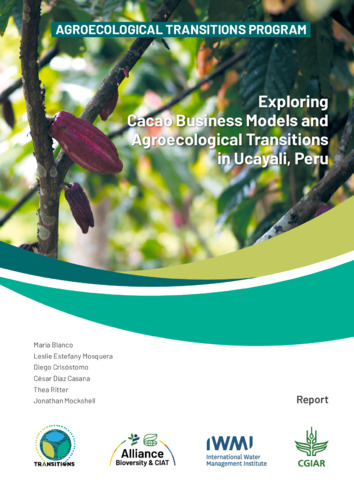Exploring cacao business models and agroecological transitions in Ucayali, Peru
Peru is internationally recognized as a significant producer and supplier of fine and aroma cacao. It is the second-largest global producer of organic cacao and has 60% of the world's cacao biodiversity (MIDAGRI, 2022). In 2009, Peruvian cocoa production was stagnant; however, since 2010 cocoa production has grown at an average annual rate of 12.6% (MIDAGRI, 2022), with the three main national cacao varieties being Trinitario, Amazonian Forastero, and Criollo. Among the various regions in Peru, San Martín is the primary national producer, followed by Junín, Ucayali, Huánuco, and Cusco (Charry et al., 2020). The Netherlands is the primary destination for Peruvian cacao, followed by Indonesia, Mexico, and other countries. Cacao holds paramount economic importance in Ucayali, Peru. It is the second-largest export product and contributes significantly to the local economy. In 2017, cacao exports from Ucayali amounted to USD 2.7 million, accounting for 10% of total exports. The department is renowned for its cacao production, with a substantial area planted in cacao farms. The crop plays a crucial role in supporting the livelihoods of smallholder farmers. Additionally, cacao production provides employment opportunities and significantly contributes to the department’s overall agricultural sector (Charry et al., 2020).
This study, integral to the Private Sector Incentives and Investments (PSii) project, conducts a meticulous exploration of cacao business models and agroecological transitions in Ucayali, Peru. Employing a combination of focus group discussions and the Business Model Canvas tool, the study provides a deep dive into the operational intricacies of cacao producers. The primary objective is to furnish cacao value-chain stakeholders with empirical insights, enabling a nuanced understanding of existing gaps and potential synergies.The findings highlight critical facets of cacao producers' business models. Despite regional variations, underlying similarities persist, underscoring the resilience of certain operational aspects. However, a marked discrepancy emerges concerning crucial partnerships, particularly in sparsely populated regions. Producers in these areas face isolation and limited support, emphasizing the urgent need for targeted interventions. Challenges faced by cacao producers encompass a spectrum of issues, from cost control and plant diseases to insufficient institutional support. Addressing these challenges is imperative for effectively facilitating agroecological practices and environmental conservation. To this end,
stakeholders must focus on delivering comprehensive support, including making resources more accessible, disseminating knowledge, and fostering sustainable cacao farming practices.
This report unpacks incentives that are essential for steering agroecological transitions. Monetary incentives, training workshops, and access to vital resources, such as organic fertilizers, are pivotal catalysts. Furthermore, innovative contracts linking international with local buyers and global initiatives are identified as crucial strategies to propel departmental agroecological transitions.

